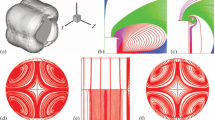Abstract
The steady-state convective motions of a viscous fluid occupying a spherical layer R1 ≤ r ≤ R2, R2/R1=1.2 are studied. The non-deformable boundaries of the layer are assumed to be free of shear stresses. At the outer boundary the constant temperature and at the inner boundary the constant heat flux are given. The system of equations in the Boussinesq approximation is solved by the Galerkin method with time stabilization on the assumption of axial and equatorial symmetry. It is shown that at the point Ra=Rac the state of mechanical equilibrium loses stability and steady symmetrical supercritical bifurcation is observed. The modes most unstable in the linear sense determine the form of convection when Ra > Rac and the supercriticality is not too great. At Rayleigh numbers Rac < Ra < 200Rac there exists a set of steady-state solutions with different spatial structures. The realization of solutions of a particular type depends on the supercriticality and the initial conditions. The evolution of the solutions with variation of the Rayleigh number is investigated. The changes in the spatial kinetic energy spectra and the integral heat fluxes upon transition from one branch of the solutions to another and with variation of the supercriticality are analyzed. As the supercriticality increases, despite the excitation of more and more new small-scale modes, the large-scale motions begin to make an ever greater contribution to the total energy. The results obtained can be used for constructing hydrodynamic models of the global motions in the atmospheres of giant planets, the convective envelopes of stars, and in the depths of the earth's mantle.
Similar content being viewed by others
Literature cited
S. Chandrasekhar, Hydrodynamic and Hydromagnetic Stability, Clarendon Press, Oxford (1961).
F. H. Busse, “Patterns of convection in spherical shells,” J. Fluid Mech.,72, 67 (1975).
F. H. Busse and N. Riani, “Patterns of convection in spherical shells. Pt. 2,” J. Fluid Mech.,123, 283 (1982).
R. E. Yuong, “Finite-amplitude thermal convection in a spherical shell,” J. Fluid Mech.,63, 695 (1974).
A. Zebib, G. Schubert, and J. M. Straus, “Infinite Prandtl number thermal convection in a spherical shell,” J. Fluid Mech.,97, 257 (1980).
A. Zebib, A. K. Goyal, and G. Schubert, “Convective motions in a spherical shell,” J. Fluid Mech.,152, 39 (1985).
B. S. Keller and I. M. Yavorskaya, “Modeling the hydrodynamic processes in the atmospheres of large planets,” in: Aeromechanics and Gas Dynamics [in Russian], Nauka, Moscow (1976), p. 256.
G. Z. Gershuni and E. M. Zhukhovitskii, Convective Stability of an Incompressible Fluid [in Russian], Nauka, Moscow (1972).
Author information
Authors and Affiliations
Additional information
Translated from Izvestiya Akademii Nauk SSSR, Mekhanika Zhidkosti i Gaza, No. 6, pp. 17–24, November–December, 1989.
Rights and permissions
About this article
Cite this article
Bogoyavlenskii, A.B. Axisymmetric convection in a spherical layer: Transitions between steady-state regimes. Fluid Dyn 24, 835–841 (1989). https://doi.org/10.1007/BF01050012
Received:
Issue Date:
DOI: https://doi.org/10.1007/BF01050012



